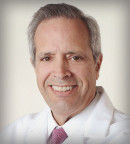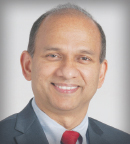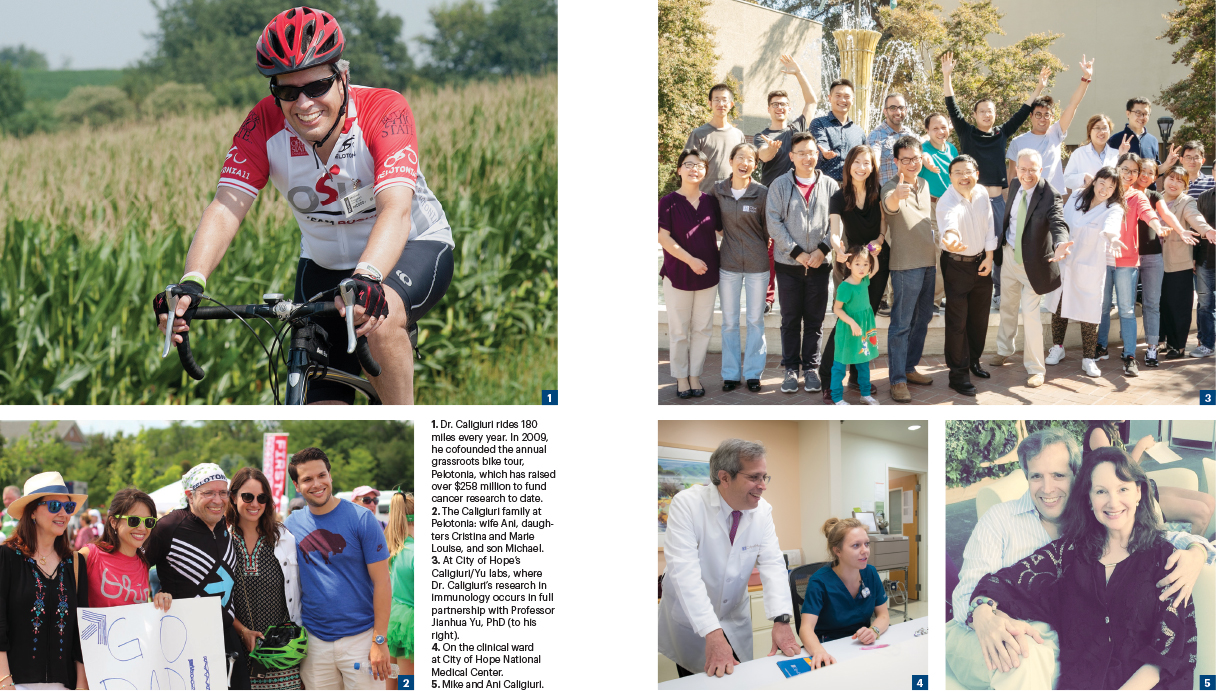In this installment of The ASCO Post’s Living a Full Life series, Guest Editor Jame Abraham, MD, FACP, spoke with Michael A. Caligiuri, MD, a physician-scientist who currently serves as President of the City of Hope National Medical Center and the Deana and Steve Campbell Physician-in-Chief Distinguished Chair, in Duarte, California. Prior to his position at City of Hope, Dr. Caligiuri was Chief Executive Officer of the Arthur G. James Cancer Hospital and Richard J. Solove Research Institute, Columbus, Ohio, and Director of the Ohio State University Comprehensive Cancer Center. He will also receive one of this year’s American Society of Hematology Mentor Awards.
MICHAEL A. CALIGIURI, MD

On his love of immunology: “Just the notion of tricking mother nature to reverse the rejection with a drug targeting T cells and have his kidney work again—it amazed me that we could do this immunologically.”
On his work at City of Hope: “I was interested in growth, culture, entrepreneurship, and pursuing different pathways to deliver innovative cancer care at a place that was really open to that—and able to put the muscle behind the vision. City of Hope has done that in spades.”
Advice for young oncologists: “Find your passion within our profession. Oncology offers unique opportunities for those who do.”
Dr. Caligiuri was born in Buffalo, New York, on January 8, 1956, the second of 10 children. “I am the grandson of four Italian immigrants who came to the United States with a collective formal education of 8 years. One of them made it to fourth grade, so you can imagine how far the other three got! They were very poor people who were part of a wave of immigrants who fled desperate conditions in Italy between 1913 and 1920. They came to this country with no language skills; they were basically manual laborers.”
Dr. Caligiuri continued: “My father’s family were, among other things, migrant workers in the farms of upstate New York—work my father did throughout elementary and high school. My mom’s father was a steam presser at a large textile manufacturing plant in Buffalo. My dad later became a salesman, and my mom was a homemaker, typical of those days.”
Learning to Love Learning
After graduating from St. Joseph’s Collegiate Institute preparatory school, Dr. Caligiuri attended the State University of New York (SUNY) at Buffalo, where he majored in humanities and health science. Asked what inspired his decision to pursue a career in medicine, Dr. Caligiuri responded: “As a kid, I never really liked science, but I always wanted to be a doctor. I worked weekends in the inner city of Buffalo at a bingo hall where I served refreshments, from the time I was about 7 or 8 years old until I was 21. It was a Black and Hispanic neighborhood, and I always wanted to return there and work as a pediatrician. So, I always aspired to pursue a career in medicine.”
During his undergraduate work, Dr. Caligiuri took premed courses and had the opportunity to spend time in Pisa, Italy, where he studied art history and the history of Italian opera and Italian literature. “It was my first real exposure to the world at large, and realizing how small I was and how little I knew was very inspiring. Most important, in going to Italy, I learned that all things are interesting; it’s just a matter of delving deeply into them. I discovered that I could get interested in science if I took the time to fully understand it, and that was liberating,” he added.
Working Through College
As he worked toward a degree in the humanities at SUNY Buffalo, Dr. Caligiuri lived at home to save money and worked two jobs to pay for his education. After graduating from SUNY Buffalo summa cum laude, he was accepted at Stanford University School of Medicine in 1978, but without a means to pay for the costly education, he entered the 5-year medical scholars program (now called The Discovery Curriculum). The program allowed him to work in a laboratory for 3 years during his preclinical training, providing free tuition and living expenses for the 3 years, as well as offering free tuition for year 5, the second clinical clerkship training year.
“I worked in a pulmonary physiology lab on the diving reflex in porpoises, seals, and turtles and spent the summers at Scripps Oceanographic Institute. But I didn’t get into science until I ended up giving lectures in cardiovascular physiology to first-year students at Stanford Medical School while in my second, third, fourth, and fifth years. At that point, I really started to understand that science could be fun and exciting for me,” he shared.
Guest Editor

Jame Abraham, MD, FACP
Dr. Abraham is Chairman of the Department of Hematology and Medical Oncology at Cleveland Clinic and Professor of Medicine at Lerner College of Medicine.
Despite his early inclination to become a pediatric physician working in the inner city, an unhappy pediatric rotation reshaped Dr. Caligiuri’s career path. “I did a rotation in general pediatrics, and it was just terrible for me. I did not realize it at the time, but I was placed with a burned-out physician who was overworked, tired, and miserable. It was enough to sour me on pediatrics,” he said.
A Bad Experience Almost
Derails a Career Path
The negative clinical experience had such a profound effect on Dr. Caligiuri, he even questioned his decision to pursue a career in medicine. “I really was lost. But while on a nephrology rotation, there was a kidney transplant patient who came in with graft rejection and unable to urinate. My resident told me that the T cells were attacking the grafted kidney, and I was going to give the patient an experimental drug called cyclosporine and stay with him, drawing blood levels until we got to a level where we quieted down his T cells. I loved our immunology course, and the plan made sense to me. I spent 2 days with this patient, administering cyclosporine, drawing blood levels, and sure enough, he started to urinate—and it just blew me away,” he said.
Dr. Caligiuri continued: “Just the notion of tricking mother nature to -reverse the rejection with a drug targeting T cells and have his kidney work again—it amazed me that we could do this immunologically. And so, I decided, I’m going to train in transplantation immunology, but having not really enjoyed my surgery rotation, I decided I would pursue bone marrow transplantation with the hope of treating blood cancers. I left Stanford in 1983 and went to Brigham and Women’s Hospital in Boston for my internal medicine residency.”
Finding His Passion
During his last year of residency, Dr. Caligiuri went to work in the laboratory of Jerry Ritz, MD, who was a bone marrow transplantation physician-scientist at Dana-Farber Cancer Institute.He began work on natural killer (NK) cells, which would spawn a central part of his research career. “I took the blood of patients with chronic fatigue syndrome in my internal medicine clinic and measured their NK cells, and we published a paper in Journal of Immunology in 1987—my first immunology publication.1 I completed my internal medicine training and entered my first year of oncology fellowship at Dana-Farber. I then spent 2 years in Jerry’s lab studying NK cell biology and have been in love with the NK cells for the past 35 years,” he said.

During his internship, Dr. Caligiuri met his future wife, Ana Maria de Jesus Pou, a nutritionist at Brigham and Women’s Hospital. They married in 1985, and with the birth of the first of their three children, Dr. Caligiuri felt the financial pressure to move to a more affordable community while trying to pursue an academic career. After considering several options, he received a timely call from Clara Bloomfield, MD, who had just moved to Roswell Park Cancer Institute in Buffalo, New York.
“Clara said she wanted me to build a bone marrow transplant program at Roswell. She said she’d give me 3 years of startup funding, a lab, and a technician—plus, I could recruit anyone I needed to do transplants in leukemia and lymphoma. It was an opportunity I couldn’t pass up,” said Dr. Caligiuri. “Then the lab started to grow, and I first received a K [Career Development] award, then an R01 and another R01. And over the 7 years I was at Roswell, I was able to advance from Assistant Professor to full Professor, which was startling to me. However, the greatest gift from Roswell Park was discovering Clara, who became my lifelong professional mentor.”
A Big Career Move,
Along With a Mentor
In 1997, Dr. Caligiuri, along with Dr. Bloomfield, moved to The Ohio State University (OSU), where he assumed the position of Associate Director for Clinical Research at the OSU Comprehensive Cancer Center (OSUCCC) and Co-Director of the Division of Hematology-Oncology. He was appointed Director of the Division of Hematology-Oncology from 2003 to 2007, and in 2005, he succeeded Dr. Bloomfield as Director of the OSUCCC until 2017.
Dr. Caligiuri’s own laboratory at OSU has studied human NK cells for more than 35 years, producing over 400 peer-reviewed publications. Discoveries from the Caligiuri Laboratory have made it possible to bring chimeric antigen receptor (CAR) NK cells from the laboratory to the cancer clinic.
“I think part of our success in building a formidable cancer program at such a large university as Ohio State stemmed from utilizing the rules and regulations of the National Cancer Institute’s Cancer Center Support Grant—to get the various university leaders aligned around what the National Cancer Institute demanded allowed us to develop a top-tier NCI–Designated Cancer Center. As CEO of the James Cancer Hospital, we were able to generate resources not only for the Cancer Center’s growth but also for other programs across the university. I was very fortunate throughout my 21-year tenure at Ohio State that, by and large, people were on board with our approach,” said Dr. Caligiuri.
Recruited by a Friend
In February 2018, Dr. Caligiuri was appointed President of the City of Hope National Medical Center and the Deana and Steve Campbell Physician-in-Chief Distinguished Chair. “My good friend Steve Rosen recruited me to City of Hope. When considering the invitation to join, I’d already been a CEO and a cancer center director. I was interested in growth, culture, entrepreneurship, and pursuing different pathways to deliver innovative cancer care at a place that was really open to that—and able to put the muscle behind the vision. City of Hope has done that in spades. I’ve been delighted with the progress we’ve made. We’ve treated over 1,000 CAR T patients, recently put $1 billion into our campus in Los Angeles, $1 billion into a new campus in Orange Country, and we recently acquired Cancer Treatment Centers of America to help us democratize innovative cancer care across the country,” said Dr. Caligiuri.
A Passion for Work
Asked how he maintains a healthy work-life balance, Dr. Caligiuri replied: “I like to say that I’ve never had to work a day in my life. I get paid to do the hobby I love, and that’s true. My wife Ani has been an amazing, fully supportive partner. I brought my laboratory from Ohio State to City of Hope and continue to work on NK cells. We’ve spun out a company, and now our first genetically engineered NK cells are in the clinic to treat patients with lung cancer, so that’s all very exciting, and I’ll continue on in that endeavor. There’s a wonderful opportunity for entrepreneurship at City of Hope that keeps me actively engaged and excited.”
Dr. Caligiuri continued: “Ani is from Puerto Rico, and so we have always enjoyed traveling to Puerto Rico. Consequently, our kids are bilingual and bicultural, which is just another wonderful gift that I was given in marrying my wife. We also love to travel to Mexico, throughout California, and of course Italy. We hope that as the pandemic subsides we’ll be doing a bit more traveling. And I love to read and study, which is a terrific way to decompress.”
Parting Words
When asked to share a parting thought, Dr. Caligiuri said: “For those in oncology who are interested in pursuing leadership, I would highly recommend developing a relationship with a mentor. I was very fortunate to have a phenomenal mentor in Clara Bloomfield, who remained my mentor even when I became her boss—I learned from her every day until she passed away about 2 years ago.”2
He added: “Just remember that anything is possible—that it’s not just about how smart you are, it’s more about how hard you work and deeply committed you are to the work. It is vital that your work be driven by passion. And cultivate your ability to be a good listener, to accept criticism, and to be introspective about your behavior. Be a nice person.”
DISCLOSURE: Dr. Caligiuri is cofounder of the NK cell company CytoImmune Therapeutics.
REFERENCE
1. Caligiuri M, Murray C, Buchwald D, et al: Phenotypic and functional deficiency of natural killer cells in patients with chronic fatigue syndrome. J Immunol 139:3306-3313, 1987.
2. Caligiuri MA. You must remember meeting Clara: Remembering Clara Derber Bloomfield (1942–2020). Cancer Res 80:1787–1789, 2020.

